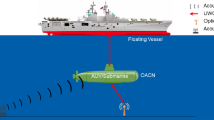Abstract
Underwater communication is an emerging field of research currently, which is an important aspect in predicting the climatic conditions accurately. Underwater communication is disadvantageous when compared with aerial communication because water is basically non transparent and blurred to electromagnetic radiations excluding visible region. In the visible region, factors such as suspended sediments and the presence of aquatic life affects the penetration of light. It may penetrate only upto a few hundreds of metres in clear water and in turbid waters, penetration is even less. Underwater communication is also affected by Intersymbol Interference (ISI) due to multipath fading. Currently, a booming and mature technology called acoustic technology is employed for underwater communication systems. Acoustic systems are proficient for long distance communication. But acoustic communication has limitations. They have very low data rates for monitoring applications and due to velocity of sound in water, it has a huge latency which means a significant time delay. To cope up with the limitations of acoustic communication, we use optical communication whose wavelength lies in the visible region. Optical communication is known for high data rate and low latency. Many accidents take place under water such as the plane crash, ship sinking. It is a tedious job to find the lost debris. Hence an underwater optical link is developed which could identify the lost debris. In this project, a hybrid model comprising of acoustic as well as the optical link is proposed. The comparison between acoustic and optical technique is studied and simulated using MATLAB simulation and the responses were plotted. The simulated results can be used in various applications including climate monitoring, military services.







Similar content being viewed by others
References
Akyildiz, I. F., Su, W., Sankarasubramaniam, Y., & Cayirci, E. (2002). A survey on sensor networks. IEEE Communications Magazine, 40, 102–114.
Akyildiz, I., Pompili, D., & Melodia, T. (2006). State of the art in protocol research for underwater acoustic sensor networks, 11, 7–16. https://doi.org/10.1145/1161039.1161043
Smart, J. H. (2005). Underwater optical communications systems part 1: Variability of water optical parameters. In MILCOM 2005—2005 IEEE military communications conference (Vol. 2, pp. 1140–1146).
Jouhari, M., Ibrahimi, K., Tembine, H., & Ben-Othman, J. (2019). Underwater wireless sensor networks: A survey on enabling technologies, localization protocols, and internet of underwater things. IEEE Access, 7, 96879–96899.
Blackmon, F., Estes, L., & Fain, G. (2005). Linear opto acoustic underwater communication. Applied Optics, 44(18), 3833–3845.
Giles, J. W., Bankman, I. N. (2005). Underwater optical communications systems. Part 2: Basic design considerations. In MILCOM 2005—2005 IEEE military communications conference (Vol. 3, pp. 1700–1705).
Hou, R., Chen, Y., Wu, J., Zhang, H. (2015). A brief survey of optical wireless communication. In Proceedings of AusPDC (pp. 41–50).
Heidemann, J., Stojanovic, M., & Zorzi, M. (2012). Underwater sensor networks: Applications, advances and challenges. Philosophical Transactions Series A, Mathematical, Physical, and Engineering Sciences, 370, 158–175. https://doi.org/10.1098/rsta.2011.0214
Campagnaro, F., Guerra, F., Diamant, R., Casari, P., Zorzi, M. (2016). Implementation of a multi-modal acoustic-optical underwater network protocol stack. In Proceedings of MTS/IEEE OCEANS.
Zheng, Y. R. (2007). Channel estimation and phase-correction for robust underwater acoustic communications. In Proceedings of IEEE military communications conference (MILCOM) (pp. 1–6).
Han, S., Noh, Y., Liang, R., Chen, R., Cheng, Y. J., & Gerla, M. (2014). Evaluation of underwater optical-acoustic hybrid network. China Communications, 11(5), 49–59.
Jonasz, M., & Fournier, G. (2007). Light scattering by particles in water: Theoretical and experimental foundations. https://doi.org/10.1016/B978-0-12-388751-1.X5000-5
Chancey, M. A. (2008). Short range underwater optical communication links
Heidemann, J., Mitra, U., Preisig, J., Stojanovic, M., Zorzi, M., & Cimini, L. (2008). Guest editorial—underwater wireless communication networks. IEEE Journal on Selected Areas in Communications, 26, 1617–1619.
Goyal, N., Dave, M., & Verma, A. K. (2016). Energy efficient architecture for intra and inter cluster communication for underwater wireless sensor networks. Wireless Personal Communications, 89, 687–707. https://doi.org/10.1007/s11277-016-3302-0
Farr, N., Bowen, A., Ware, J., Pontbriand, C., Tivey, M. (2010). An integrated, underwater optical/acoustic communications system. In OCEANS’10 IEEE SYDNEY (pp. 1–6).
Stefanov, A., & Stojanovic, M. (2011). Design and performance analysis of underwater acoustic networks. IEEE Journal on Selected Areas in Communications, 29, 2012–2021.
Elgala, H., Mesleh, R., & Haas, H. (2011). Indoor optical wireless communication: potential and state-of-the-art. IEEE Communications Magazine, 49, 56–62.
Bharamagoudra, M. R., & Manvi, S. K. S. (2016). Deployment scheme for enhancing coverage and connectivity in underwater acoustic sensor networks. Wireless Personal Communications, 89, 1265–1293. https://doi.org/10.1007/s11277-016-3315-8
Johnson, L. J., Jasman, F., Green, R. J., & Leeson, M. S. (2014). Recent advances in underwater optical wireless communications. Underwater Technology, 32(3), 167–175.
Moriconi, C., Cupertino, G., Betti, S., Tabacchiera, M. (2015). Hybrid acoustic/optic communications in underwater swarms. In OCEANS 2015—Genova (pp. 1–9).
Alomari, M. M., Wafa, M., Babhair, G. G., & Hemalatha, M. (2017). Vision and challenges of underwater optical wireless communication-a survey. IEEE Access, 167, 8–10.
Stojanovic, M., & Preisig, J. (2009). Underwater acoustic communication channels: Propagation models and statistical characterization. IEEE Communications Magazine, 47, 84–89.
Doniec, M., Vasilescu, I., Chitre, M., Detweiler, C., Hoffmann-Kuhnt, M., & Rus, D. (2009). Aquaoptical: A lightweight device for high-rate long-range underwater point-to-point communication. OCEANS, 2009, 1–6.
Author information
Authors and Affiliations
Corresponding author
Additional information
Publisher's Note
Springer Nature remains neutral with regard to jurisdictional claims in published maps and institutional affiliations.
Rights and permissions
About this article
Cite this article
Gauni, S., Manimegalai, C.T., Krishnan, K.M. et al. Design and Analysis of Co-operative Acoustic and Optical Hybrid Communication for Underwater Communication. Wireless Pers Commun 117, 561–575 (2021). https://doi.org/10.1007/s11277-020-07883-1
Published:
Issue Date:
DOI: https://doi.org/10.1007/s11277-020-07883-1




